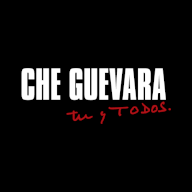
Install this Che Tu I Todos on your iPhone  and then Add to Home Screen
and then Add to Home Screen
1942-1949 Album
Ernesto grew up. His cultural interests were unusual for an adolescent – at the age of 14 he had already read Freud. At seventeen he kept a philosophy notebook, in which he recorded names, quotes and schools of thought. He became an athlete and learnt to live with his condition. He was popular with girls. His teachers liked him and during discussions he spoke to them as an equal. He was not particularly interested in politics. He wanted to become an engineer. When the grandmother he was close to became ill, he rushed to her side, but eventually she died. Ernesto changed his mind and enrolled in medicine. His friend Tita Infante said, “It was the beginning of 1947. In a hall of anatomy in the faculty of medicine I heard a warm, deep voice several times […]. Judging by his accent, he too was from out of town. He looked like a confident, handsome boy.”
1950-1952 Album
On 1st January, 22-year-old Ernesto set off for the Argentinian provinces on a bicycle with a Garelli motor. He travelled for over four thousand, five hundred kilometers. Of his journey, Guevara said, “I do not travel as a tourist and I am surprised to see the Altar of the Country – where the flag was blessed – in advertising leaflets. […] That is not the way to recognize the people of a nation, their way of being and of interpreting life […].”
Ernesto became engaged to a pretty girl from one of the most important families in the region, Chichina Ferreira, who said, “I was fascinated by his strong build and unconventional character. […] He always wore a transparent nylon shirt that had turned grey through wear. He wore mismatching shoes bought at the sales […].” In December 1951 Guevara, in the company of Alberto Granado, started a journey that led him across the South American continent for the first time. The trip started on a Norton motorcycle called “Poderosa II” and ended in July 1952.
Ernesto kept a diary, which was edited by the author into a travel diary, called Notas de viaje, Notes on a Latin American journey. Picaresque events alternated with descriptions of landscapes and the conditions people lived in. It was the beginning of a true Latin American thought, as well as the future of a revolutionary to the bone.
1953-1956 Album
In July 1953 he started his second journey across Latin America, “Otra Vez”, following a pre-established route. He wanted to visit Bolivia and learn more about the 1952 revolution. The wanderings began again, leading Ernesto’s political opinions to become more radical. He moved from Bolivia to Guatemala, a country that filled him with enthusiasm because of the apparently successful ongoing agrarian revolution. He was soon bitterly disappointed – when Jacobo Árbenz Guzmán, the president of Guatemala, tried to nationalize the United Fruit Company (the American company that controlled most of the country’s agricultural land) the CIA reacted with bombs and machine-guns. Arbenz gave in to the ultimatum of the army. Guevara moved to Mexico. He earned a living as a photographer. He married Hilda Gadea, a Peruvian economist he had met in Guatemala, and their daughter Hilda Beatriz was born on 15th February 1956. In Mexico Guevara met Fidel Castro, the leader of the anti-Batista movement. They liked each other and they shared a wish to end dictatorship. The Cuban patriots trained for an expedition in Cuba, but they were arrested (and later released). Guevara wrote to his mother from jail, “During these days in jail […] I have completely identified with my companions in their cause. I remember a sentence that one day sounded stupid (or strange at the least), regarding the total identification among all the members of a fighting body, in which the concept of ‘I’ vanishes completely and is replaced by the concept of ‘us’.” Shortly afterwards 82 rebel fighters left on the Granma yacht and headed for Cuba, with the aim of freeing it from tyranny.